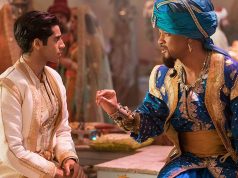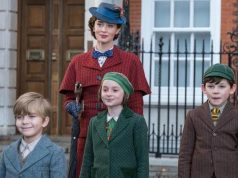If you walked out of “National Treasure” three years ago thinking, “OK, that was kind of fun but it sure was ridiculous,” then I’m here to tell you, you ain’t seen nothin’ yet. The sequel, “National Treasure: Book of Secrets,” is twice as ridiculous and half as fun. It’s based on a flimsy premise, and then that flimsy premise is abused and twisted to the point that you wonder how anyone involved could possibly have thought what they were doing was coherent.
It goes like this. Noted treasure hunter and historian Ben Gates (Nicolas Cage) and his father Patrick (Jon Voight) are very proud of Patrick’s great-grandfather, Thomas Gates, who helped foil a Confederate plot just after the Civil War. Imagine their horror, then, when a mysterious fellow named Mitch Wilkinson (Ed Harris) shows up with one of the famous missing pages from John Wilkes Booth’s diary, and that page seems to implicate old Grandpa Gates in the conspiracy to kill Abraham Lincoln!
Patrick is despondent. Ben is furious and disbelieving. He must clear his great-great-grandfather’s name. He must! Why, if schoolchildren grew up thinking Thomas Gates was a conspirator in the Lincoln assassination, that would be … well, it would be taking place in a parallel universe. No one in this universe knows any name other than Booth’s when it comes to the Lincoln assassination.
The film tries to make us forget that. There’s one funny (but ridiculous) moment where a little boy, having heard the news about ol’ Thomas Gates, confronts Ben about it on the White House lawn. (“See?!” the movie seems to say. “Ben’s life is being ruined already!!”) In another scene, Ben mentions how Samuel Mudd, the doctor who provided assistance to the injured Booth, still lives in infamy in the expression “his name is mud.” Surely we do not want such a fate to befall the Gates family! Fine, except that five seconds of Googling yields the fact that “his name is mud” pre-dates the Lincoln assassination by at least 45 years and has no connection whatsoever to Samuel Mudd.
So already I am not terribly invested in Ben Gates’ insane quest to clear his forefather’s name. Maybe he was a Booth conspirator. Maybe he wasn’t. Who cares? I promise you, the answer is no one.
But the movie takes it even further. Ben’s method of proving Thomas Gates’ innocence is to prove why his name was really on that diary page: He was helping the Union find a hidden treasure before the Confederacy did, to prevent it from falling into Rebel hands. If Ben can follow the clues to this treasure, it will prove his great-great-grandfather was innocent!
Did you catch that? Do you see the connection between finding the treasure and proving Thomas Gates was not a Booth cohort? Neither do I. But the movie is convinced that it’s a simple “if/then” statement, that all Ben has to do is get a picture on the front page of the paper of him standing next to a pile of gold and everything will be settled.
Ben makes a lot of crazy assumptions. He and his assistant Riley (Justin Bartha), the one who has the funny one-liners, find a clue suggesting the Statue of Liberty replica in Paris. They go all the way to Paris and use a remote-control helicopter with a camera attached to it to fly up and read the statue’s inscription — rather than, say, looking it up on the Internet. From there Ben leaps to the conclusion that since “twin” and “resolute” both appear in the inscription, that must mean that additional clues are hidden inside the so-called “resolute desks” that sit in the queen’s office at Buckingham Palace and the Oval Office at the White House. I mean, what else could a veiled, cryptic message — in French, which Ben does not speak — possibly mean?
When Ben needs to take a photo of something but his cell phone’s camera won’t work, he simply holds the item up while running a red light in London, then has Riley hack into London’s computer system to retrieve the picture that the traffic camera took.
Foreseeing the audience’s complaints that Ben behaves recklessly and implausibly, the film has his estranged girlfriend Abigail (Diane Kruger) cite it as one of her beefs with him. She doesn’t like how he always assumes things that, yes, turn out to be true, but that he had no logical reason to assume. It’s a fair complaint.
But you know what, movie? Acknowledging the outrageous flaws in your main character does not make them OK. In a way it’s worse. You’re basically saying, “Yes, we realize none of this makes any sense. But fixing it would have been too hard, and we’re really not that concerned.”
The screenplay is by husband-and-wife team Cormac and Marianne Wibberley (credited, too cutely, as just “The Wibberleys”), who previously had a hand in such unfortunate endeavors as “I Spy,” “Charlie’s Angels: Full Throttle,” “Bad Boys II,” “The Shaggy Dog,” and the first “National Treasure” — which, looking at that list, appears to be the best thing they’ve ever done. They are reunited here with director Jon Turteltaub, still an enthusiastic proponent of daffy action sequences and cheerful nonsense.
Helen Mirren is in the film as Ben’s mother, Patrick’s ex-wife. She is an expert in pre-Columbian American languages. Bruce Greenwood is in the film as the current U.S. president, his name never given. He is a fan of American history and is gullible enough to be led into a tunnel under Mount Vernon by Ben. I could sit here all day and tell you the goofy things that happen in this movie, but I suspect you’ll enjoy it more (or not) if you see for yourself.
C (2 hrs., 4 min.; )





